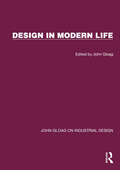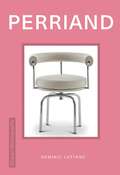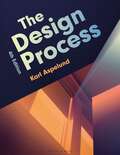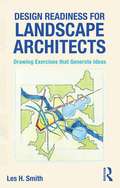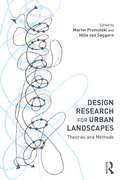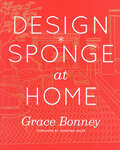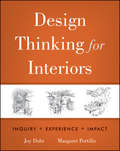- Table View
- List View
Design in Modern Life (John Gloag On Industrial Design Ser.)
by John GloagOriginally published in 1946, this book is based on a series of broadcast talks on design. Led by an engineer, an artist and critic of architecture and industrial design, the discussions focussed on the problems that were involved by a general application of design to the environment of contemporary life. It surveys the possibilities of design in modern life and the talks have been rewritten, amplified and revised for the purposes of the book.
Design in Modern Life (John Gloag On Industrial Design Ser.)
by John GloagOriginally published in 1946, this book is based on a series of broadcast talks on design. Led by an engineer, an artist and critic of architecture and industrial design, the discussions focussed on the problems that were involved by a general application of design to the environment of contemporary life. It surveys the possibilities of design in modern life and the talks have been rewritten, amplified and revised for the purposes of the book.
Design Mom: How to Live with Kids: A Room-by-Room Guide
by Gabrielle Stanley BlairNew York Times best seller Ever since Gabrielle Stanley Blair became a parent, she&’s believed that a thoughtfully designed home is one of the greatest gifts we can give our families, and that the objects and decor we choose to surround ourselves with tell our family&’s story. In this, her first book, Blair offers a room-by-room guide to keeping things sane, organized, creative, and stylish. She provides advice on getting the most out of even the smallest spaces; simple fixes that make it easy for little ones to help out around the house; ingenious storage solutions for the never-ending stream of kid stuff; rainy-day DIY projects; and much, much more.
Design Monograph: Eames
by Naomi StungoA design monograph series on the most remarkable architects, designers, brands and design movements of the twentieth and twenty-first centuries, each book contains a historical-critical essay discussing the life and work of the subject, followed by an illustrated appreciation of groundbreaking work.Charles and Ray Eames were the golden couple of postwar American design. True multimedia pioneers, they worked in furniture design, architecture, print, photography and filmmaking. They imbued the modern twentieth-century aesthetic with originality, colour and freshness, and their ability to mould plastics and plywood with an elegance not previously seen resulted in some of the most influential furniture design of the modern age – witnessed not just in the continuing popularity of their original designs but also in the mass prodcution of countless imitations.
Design Monograph: Gaudí
by Judith Carmel-ArthurA design monograph series on the most remarkable architects, designers, brands and design movements of the twentieth and twenty-first centuries, each book contains a historical-critical essay discussing the life and work of the subject, followed by an illustrated appreciation of groundbreaking work.The 'Dante of architecture', Antoni Gaudí crafted extraordinary constructions out of minute and mesmerizing details, transforming fantastical visions into realities on the city streets of Barcelona. His work merged the influences of Orientalism, natural forms, new materials and religious faith into a unique aesthetic. From the furnishings of the Güell Palace to his masterpiece, the still-incomplete Sagrada Família, his imaginative creations are celebrated in this curated selection of images, accompanied by an essay of his life and work.
Design Monograph: Perriand
by Dominic LutyensA design monograph series on the most remarkable architects, designers, brands and design movements of the twentieth and twenty-first centuries, each book contains a historical-critical essay discussing the life and work of the subject, followed by an illustrated appreciation of groundbreaking work.French architect and designer Charlotte Perriand not only created buildings such as the League of Nations in Geneva and ski resorts but was responsible for iconic furniture pieces in tubular steel, such as the Nuage bookshelf, Grand Confort chair (while working for Le Corbusier), B301 recliner and the ponyskin Chaise Longue.
Design Monograph: Starck
by Judith Carmel-ArthurA design monograph series on the most remarkable architects, designers, brands and design movements of the twentieth and twenty-first centuries, each book contains a historical-critical essay discussing the life and work of the subject, followed by an illustrated appreciation of groundbreaking work.With his vivid imagination, wit and flair, Philippe Starck has transformed everyday objects into icons of modern design, heralding in the democratic design movement that has influenced what we buy and how we live. Among instantly recognizable classics such as the long-legged Juicy Salif lemon squeezer and the much imitated Sissi Lamp, Starck has created some of the world's most ground-breaking furniture, interiors, hotels and architecture, all of which are celebrated in this curated selection of images, accompanied by a critical essay of his life and work.
The Design of Lighting
by Peter Tregenza David LoeThis fully updated edition of the successful book The Design of Lighting, provides the lighting knowledge needed by the architect in practice, the interior designer and students of both disciplines. The new edition offers a clear structure, carefully selected material and linking of lighting with other subjects, in order to provide the reader with a comprehensive and specifically architectural approach to lighting. Features of this new edition include: technical knowledge of lighting in the context of architectural design; an emphasis on imagination in architectural light and presentation of the tools necessary in practice for creative design; additional chapters on the behaviour of light and on the context of design; a strong emphasis on sustainable design and energy saving, with data and examples; analyses of actual lighting schemes and references to current standards and design guides; an up-to-date review of lamp and lighting technology, with recommendations on the choice of equipment; a revision of the calculation section, with examples and step-by-step instructions, based on recent student feedback about the book.
The Design of Lighting
by Peter Tregenza David LoeThis fully updated edition of the successful book The Design of Lighting, provides the lighting knowledge needed by the architect in practice, the interior designer and students of both disciplines. The new edition offers a clear structure, carefully selected material and linking of lighting with other subjects, in order to provide the reader with a comprehensive and specifically architectural approach to lighting. Features of this new edition include: technical knowledge of lighting in the context of architectural design; an emphasis on imagination in architectural light and presentation of the tools necessary in practice for creative design; additional chapters on the behaviour of light and on the context of design; a strong emphasis on sustainable design and energy saving, with data and examples; analyses of actual lighting schemes and references to current standards and design guides; an up-to-date review of lamp and lighting technology, with recommendations on the choice of equipment; a revision of the calculation section, with examples and step-by-step instructions, based on recent student feedback about the book.
Design Out Crime
by Ian ColquhounHere is a book about the practical design of communities and housing in which people can enjoy a good quality of life, free from crime and fear of crime.Recognising that crime, vandalism and anti-social behaviour are issues of high public concern, and that the driving forces behind crime are numerous, this book argues that good design can help tackle many of these issues. It shows how, through integrating simple crime prevention principles in the design process, it is possible, almost without notice, to make residential environments much safer.Written from the perspective of an architect and town planner, this book offers practical design guidelines through a set of accessible case studies drawn from the UK, USA, The Netherlands and Scandinavia. Each example illustrates how success comes when design solutions reflect local characteristics and where communities are truly sustainable; where residents feel they belong, and where crime is dealt with as part of the bigger picture of urban design.
Design Out Crime
by Ian ColquhounHere is a book about the practical design of communities and housing in which people can enjoy a good quality of life, free from crime and fear of crime.Recognising that crime, vandalism and anti-social behaviour are issues of high public concern, and that the driving forces behind crime are numerous, this book argues that good design can help tackle many of these issues. It shows how, through integrating simple crime prevention principles in the design process, it is possible, almost without notice, to make residential environments much safer.Written from the perspective of an architect and town planner, this book offers practical design guidelines through a set of accessible case studies drawn from the UK, USA, The Netherlands and Scandinavia. Each example illustrates how success comes when design solutions reflect local characteristics and where communities are truly sustainable; where residents feel they belong, and where crime is dealt with as part of the bigger picture of urban design.
Design Portfolios: Presentation and Marketing for Interior Designers
by Diane BenderToday's students of architecture, interior design, and landscape design need to master the art of marketing themselves via multiple print and digital formats. This third edition of Design Portfolios reflects contemporary portfolio practices and enables students to create portfolios that serve as both evolving collections of creative solutions to design problems and evidence of their abilities to visually relay messages. Readers will learn how to create not just a collection of design work but a unique marketing tool for a successful design career.
The Design Process: - with STUDIO
by Karl AspelundIn The Design Process, Fourth Edition author Karl Aspelund takes readers on a guided tour through the seven stages of design: from the initial Inspiration to Identification, Conceptualization, Exploration/Refinement, Definition/Modeling, Communication, and all the way through Production. This book focuses on developing a solid foundation in design critical thinking, no matter the discipline. The author highlights the all important factors of sustainability, teamwork, and how to best communicate with client or manufacturer. Each chapter is followed by an exercise that allows you to work on one full cross-disciplinary project continuously from brainstorm to a physical product. The appendices provide key references to further readings, artist profiles, design elements and principles, trend analysis, and history of modern design (from the 1800s through to the 21st century). This is the perfect book to make your design dreams into design reality.New to This Edition:-Updated examples, exercises, bibliography, and timelines-Revised coverage of sustainability reflects the newest findings in the field-New and revised Perspectives offer real life examples from artists and designers across fashion, interior design, public arts projects, and industrial and consumer productsInstructor Resources-Instructor's Guide provides suggestions for planning the course and using the text in the classroom, supplemental assignments, and lecture notes-Test Bank includes sample test questions for each chapter-PowerPoint® presentations include images from the book and provide a framework for lecture and discussionSTUDIO Includes: -Study smarter with self-quizzes featuring scored results and personalized study tips
The Design, Production and Reception of Eighteenth-Century Wallpaper in Britain (The Histories of Material Culture and Collecting, 1700-1950)
by Clare TaylorWallpaper’s spread across trades, class and gender is charted in this first full-length study of the material’s use in Britain during the long eighteenth century. It examines the types of wallpaper that were designed and produced and the interior spaces it occupied, from the country house to the homes of prosperous townsfolk and gentry, showing that wallpaper was hung by Earls and merchants as well as by aristocratic women. Drawing on a wide range of little known examples of interior schemes and surviving wallpapers, together with unpublished evidence from archives including letters and bills, it charts wallpaper’s evolution across the century from cheap textile imitation to innovative new decorative material. Wallpaper’s growth is considered not in terms of chronology, but rather alongside the categories used by eighteenth-century tradesmen and consumers, from plains to flocks, from China papers to papier mâché and from stucco papers to materials for creating print rooms. It ends by assessing the ways in which eighteenth-century wallpaper was used to create historicist interiors in the twentieth century. Including a wide range of illustrations, many in colour, the book will be of interest to historians of material culture and design, scholars of art and architectural history as well as practicing designers and those interested in the historic interior.
The Design, Production and Reception of Eighteenth-Century Wallpaper in Britain (The Histories of Material Culture and Collecting, 1700-1950)
by Clare TaylorWallpaper’s spread across trades, class and gender is charted in this first full-length study of the material’s use in Britain during the long eighteenth century. It examines the types of wallpaper that were designed and produced and the interior spaces it occupied, from the country house to the homes of prosperous townsfolk and gentry, showing that wallpaper was hung by Earls and merchants as well as by aristocratic women. Drawing on a wide range of little known examples of interior schemes and surviving wallpapers, together with unpublished evidence from archives including letters and bills, it charts wallpaper’s evolution across the century from cheap textile imitation to innovative new decorative material. Wallpaper’s growth is considered not in terms of chronology, but rather alongside the categories used by eighteenth-century tradesmen and consumers, from plains to flocks, from China papers to papier mâché and from stucco papers to materials for creating print rooms. It ends by assessing the ways in which eighteenth-century wallpaper was used to create historicist interiors in the twentieth century. Including a wide range of illustrations, many in colour, the book will be of interest to historians of material culture and design, scholars of art and architectural history as well as practicing designers and those interested in the historic interior.
Design Readiness for Landscape Architects: Drawing Exercises that Generate Ideas
by Les H. SmithDemands on landscape architecture students’ time are many and varied – when is there a chance to just sketch, and is it worth dedicating your time to the pursuit of drawing? This book shows how in short bursts you can build up your design skills using quick, relaxed sketches, which form the basis for full projects and studio work. This book will provide you with your own image library – sources of inspiration, guidance, and short-cuts to future designs. A variety of paths leading to design discovery, based upon experimental sketching methods, are discussed, demonstrated, and then put into action with valuable exercises. These exercises focus your sketching, giving hints and tips on what to look for, how to capture the essence of the object or location, and how to become a natural in the art of speedy visual communication. Real-life examples of the author’s built-works as a landscape architect show how professionals use these techniques in their own design creations. Design Readiness for Landscape Architects presents enjoyable and thought-stirring essays and drawing-based exercises to help students grow more facile and agile in their service as architects of the land, whether using tablets, paints, or pens and pencils.
Design Readiness for Landscape Architects: Drawing Exercises that Generate Ideas
by Les H. SmithDemands on landscape architecture students’ time are many and varied – when is there a chance to just sketch, and is it worth dedicating your time to the pursuit of drawing? This book shows how in short bursts you can build up your design skills using quick, relaxed sketches, which form the basis for full projects and studio work. This book will provide you with your own image library – sources of inspiration, guidance, and short-cuts to future designs. A variety of paths leading to design discovery, based upon experimental sketching methods, are discussed, demonstrated, and then put into action with valuable exercises. These exercises focus your sketching, giving hints and tips on what to look for, how to capture the essence of the object or location, and how to become a natural in the art of speedy visual communication. Real-life examples of the author’s built-works as a landscape architect show how professionals use these techniques in their own design creations. Design Readiness for Landscape Architects presents enjoyable and thought-stirring essays and drawing-based exercises to help students grow more facile and agile in their service as architects of the land, whether using tablets, paints, or pens and pencils.
Design Research for Urban Landscapes: Theories and Methods
by Martin Prominski Hille SeggernWithin the spatial design disciplines, research through design as a tool and practice has often been neglected. This book provides a much-needed companion to the theories, methods and processes involved in using design-based research in landscape, architecture and urban design. Aimed specifically at researchers completing PhD projects, supervisors and designers working in practice, it covers applied approaches to help you to use design research in your work. With fully illustrated examples of original international design research PhDs from a variety of programme types, such as individual, structured and practice-based, Design Research for Urban Landscapes offers PhD candidates and supervisors a clear foundational pathway.
Design Research for Urban Landscapes: Theories and Methods
by Martin Prominski Hille SeggernWithin the spatial design disciplines, research through design as a tool and practice has often been neglected. This book provides a much-needed companion to the theories, methods and processes involved in using design-based research in landscape, architecture and urban design. Aimed specifically at researchers completing PhD projects, supervisors and designers working in practice, it covers applied approaches to help you to use design research in your work. With fully illustrated examples of original international design research PhDs from a variety of programme types, such as individual, structured and practice-based, Design Research for Urban Landscapes offers PhD candidates and supervisors a clear foundational pathway.
Design*Sponge at Home
by Grace BonneyThe long-awaited home décor bible by the beloved design blogger&“Thank you,&” wrote a reader to Design*Sponge creator Grace Bonney, &“for teaching me that houses don&’t have to be frumpy and formal. They don&’t have to be matchy-matchy or rigidly modern.&” They can just be comfy and unique and reflect who you are, no matter how small your budget or space.That reader is one of the 75,000 unique daily visitors to Design*Sponge, who make it the most popular design site on the web. The site receives 250,000 pageviews every day and has 150,000 RSS subscribers and 280,000 followers on Twitter. Design*Sponge fans have been yearning for the ultimate design manual from their guru, Grace, and she has finally delivered with this definitive guide, which includes:• Home tours of 70 real-life interiors featuring artists and designers• Fifty DIY projects, with detailed instructions for personalizing your space• Step-by-step tutorials on everything from stripping and painting furniture to hanging wallpaper and doing your own upholstery• Fifty Before & After makeovers submitted by readers of Design*Sponge—real people with limited time and realistic budgets• Essential tips on modern flower arranging, with 20 arrangementsWith over 700 color photos and illustrations and projects that are customizable, relatable, and affordable, this is the democratizing design book everyone has been waiting for.
Design Thinking for Interiors: Inquiry, Experience, Impact
by Joy H. Dohr Margaret PortilloTake a holistic approach to contemporary interior design. The interior design process is changing. In order to create truly engaging work, designers are developing a deeper and broader understanding of how design theory, research, and existing practice can help them make better decisions. This inquiry provides answers on how design is experienced, and its impact over time. At the same time, the profession is becoming increasingly collaborative. Designers today work closely with other professionals—such as architects, landscape designers, product designers, anthropologists, and business consultants—in new ways, engaging an expanding network of experts in the design process more than ever before. Written by renowned scholars Joy Dohr and Margaret Portillo, the book brings interior design theory and research to life utilizing a narrative inquiry approach that offers highly accessible coverage of the interior design world as it exists today. By looking at real-life stories that demonstrate what makes a memorable design, coupled with photographs and drawings to further illustrate these concepts, this book is a must-read for anyone interested in keeping abreast of interior design in the twenty-first century.
Design Thinking for Interiors: Inquiry, Experience, Impact
by Joy H. Dohr Margaret PortilloTake a holistic approach to contemporary interior design. The interior design process is changing. In order to create truly engaging work, designers are developing a deeper and broader understanding of how design theory, research, and existing practice can help them make better decisions. This inquiry provides answers on how design is experienced, and its impact over time. At the same time, the profession is becoming increasingly collaborative. Designers today work closely with other professionals—such as architects, landscape designers, product designers, anthropologists, and business consultants—in new ways, engaging an expanding network of experts in the design process more than ever before. Written by renowned scholars Joy Dohr and Margaret Portillo, the book brings interior design theory and research to life utilizing a narrative inquiry approach that offers highly accessible coverage of the interior design world as it exists today. By looking at real-life stories that demonstrate what makes a memorable design, coupled with photographs and drawings to further illustrate these concepts, this book is a must-read for anyone interested in keeping abreast of interior design in the twenty-first century.
Designed for Habitat: Collaborations with Habitat for Humanity
by David Hinson Justin MillerIf you're looking for ways to give back to your community, then this book, the first to profile thirteen projects designed and built by architects and Habitat for Humanity, will help. Detailed plans, sections, and photographs show you how these projects came about, the strategies used by each team to approach the design and construction process, and the obstacles they overcame to realize a successful outcome. The lessons and insights, presented here will aid you, whether you're an architect, architecture student, Habitat affiliate leader, or an affordable housing advocate. Located all across the United States, these projects represent the full spectrum of Habitat for Humanity affiliates, from large urban affiliates to small rural programs. These cases illustrate a broad range of innovative approaches to energy performance, alternative construction strategies, and responses to site context. And each house demonstrates that design quality need not fall victim to the rigorous imperatives of cost, delivery, and financing.
Designed for Habitat: Collaborations with Habitat for Humanity
by David Hinson Justin MillerIf you're looking for ways to give back to your community, then this book, the first to profile thirteen projects designed and built by architects and Habitat for Humanity, will help. Detailed plans, sections, and photographs show you how these projects came about, the strategies used by each team to approach the design and construction process, and the obstacles they overcame to realize a successful outcome. The lessons and insights, presented here will aid you, whether you're an architect, architecture student, Habitat affiliate leader, or an affordable housing advocate. Located all across the United States, these projects represent the full spectrum of Habitat for Humanity affiliates, from large urban affiliates to small rural programs. These cases illustrate a broad range of innovative approaches to energy performance, alternative construction strategies, and responses to site context. And each house demonstrates that design quality need not fall victim to the rigorous imperatives of cost, delivery, and financing.
Designed for Habitat: New Directions for Habitat for Humanity
by David Hinson Justin MillerDesigned for Habitat: New Directions for Habitat for Humanity presents 12 new projects designed and built via collaborations between architects and Habitat for Humanity®. The ways in which we think about affordable housing are being challenged by designers and not-for-profit housing advocates such as Habitat for Humanity and its affiliates. The projects chronicled in this book consider home affordability through the lens of monthly homeownership expenses, energy efficiency and residential energy use, and issues of designed resilience to natural events ranging from aging and accessibility concerns to natural disasters and climate change. New to this edition, the projects reflect new approaches to building scale, construction technology, energy and affordability, and design and context. Illustrated with over 100 color images, the case studies include detailed plans and photographs to show how these projects came about, the strategies used by each team to approach the design and construction process, and the obstacles they overcame to realize a successful outcome. The lessons and insights presented will be a valuable resource, whether you’re an architect, an architecture student, a Habitat affiliate leader, or an affordable housing advocate.
